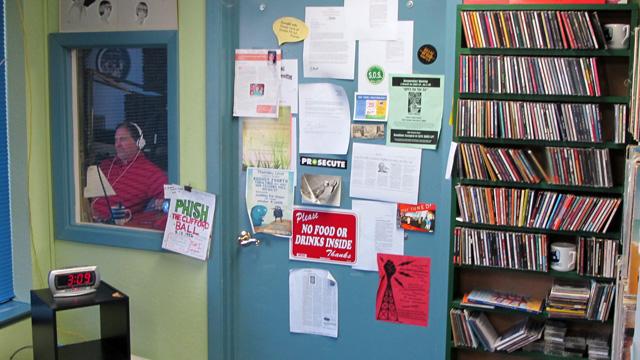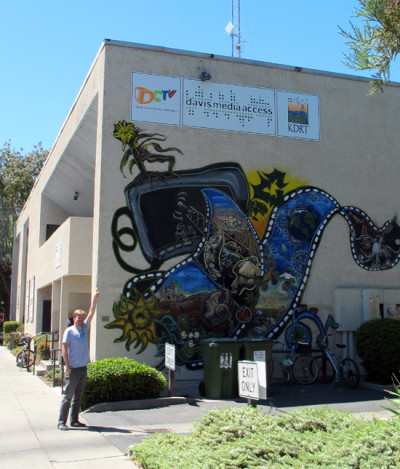Low Power Radio Stations Vie for FCC Licenses

Low Power Radio Stations Vie for FCC Licenses
If you’ve ever wanted to start your own radio station, this is your big chance. The Federal Communications Commission (FCC) is now taking applications for small stations, with a broadcast range of less than ten miles in most cases. Advocates and applicants for Low Power FM Radio -- or LPFM, as it's known, are hoping to create dozens of hyperlocal stations across California.
KDRT in Davis, CA is a well-known LPFM station, although it only has a range of three miles from its downtown transmitter.
The 100-watt station features weekly talk shows like “Davisville”, which features local newsmakers, and “That’s Life” hosted by Lois Richter.
“I interview local people about what they do,” explains Richter.
“So I will talk to you and say, “So what’s a dog catcher anyway?” Or maybe you went someplace and want to tell us about your trip, or maybe there is an event coming up or some community club that’s doing something,” she adds. Richter also co-hosts a show with a local gardening expert. He knows the area so well that he asks callers what street they live on, so he can diagnose their particular soil.
Although it may sound quaint to have such a local focus, says Richter, Davis lives in the major media shadow of Sacramento, 15 miles away.
“People (are) not going to get election programming from a Sacramento station,” says KDRT station director Jeff Shaw.
“They're going to tune into KDRT in order to hear their local politicians who they're voting for, give their election statement or their election night interviews. They're not going to get that anywhere else except for on KDRT,” Shaw adds.

Shaw helped get KDRT on the air in 2004, a multi-year process that began in 2000 when the FCC opened the first-ever application window for Low Power FM stations. He’s now working with a group called Common Frequency, spreading the word about this new opportunity.
“Dealing with the FCC is probably the most difficult part,” says Shaw.
The FCC has a point system to decide who’s awarded the available frequencies. Applicants get a point for committing to broadcast at least 12 hours a day, and for playing eight hours a day of locally produced programs. Since these are non-commercial broadcast licenses, only non-profits can apply. And organizations that have existed for at least two years get another point.
“It's not really a service that lends itself to networks or chains,” explains Peter Doyle, chief of the audio division at the Federal Communications Commission’s media bureau. “We're hoping that what we're going to get from this process is many, many independent new voices based on those licensing rules,” he says.
[KDRT station director Jeff Shaw in front on KDRT, a project of Davis Media Access. Shaw helped get the low power station on air in 2004.(Image credit: Andrew Stelzer/KQED)]
Andrew Stelzer/KQED
KDRT station director Jeff Shaw in front on KDRT, a project of Davis Media Access. Shaw helped get the low power station on air in 2004.
And most significant, compared to the first round of licenses granted, is that this time urban areas are included. That’s because last time around in 2000, the broadcast lobby convinced Congress that a new station, even a very small one, could interfere with their established signals. That put most of the unclaimed broadcast real estate off-limits.
KDRT’s Shaw was among the low power radio advocates who spent years calling on Congress to overturn that rule, which it did in 2010. That means a lot more stations will be in places where even with a range of only a few miles, they can reach large numbers of people.
“We're going to see a lot more new stations start up in metropolitan areas and even suburban areas, like Sacramento, Chico -- even in places like LA or Pasadena we’ll see new stations and groups applying,” says Shaw.
But competition will likely be fierce in LA and the Bay Area. Even with the new rules, there isn’t room for more than a few stations on a crowded dial. The FCC has a complex set of rules to settle situations with multiple qualified applicants.
Alameda Community Radio, a group applying to create a station on the small island city of Alameda, less than a minute's drive over a bridge from Oakland, has been laying the groundwork for their application for almost two years. Peter Franck, chair of Alameda Community Radio’s Board of Directors, says they hope to broadcast local high school sports events, and provide an outlet for local artists and musicians.
“There is a strong feeling that Alameda being a small island right off Oakland is ignored by most of the media in the Bay Area, and that we wanted to have a Alameda-centric, Alameda-based radio station,” says Franck.
With food, business, and just about everything going hyperlocal, advocates say it’s time for radio to do the same.
“Although we have increasingly amazing access to what's happening globally, we’re missing what's happening locally," says Brandy Doyle (no relation to the FCC’s Peter), who works with the Prometheus Radio Project, a group that helps build community radio stations all over the world.
“People are seeing a need to have news and information on the local level and that's something that's not being fully met by our digital media landscape yet," says Doyle.
The window to apply for a station is open through November 14th. New stations could start hitting the airwaves by mid-2014.

